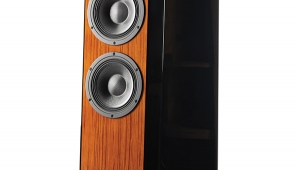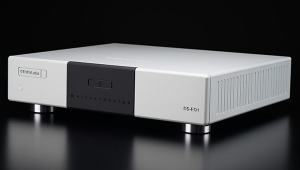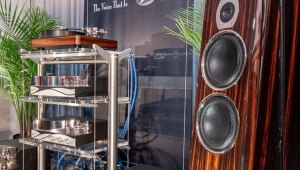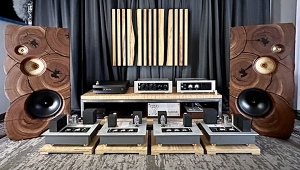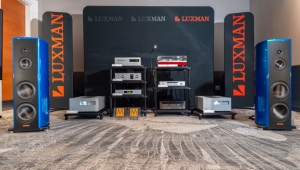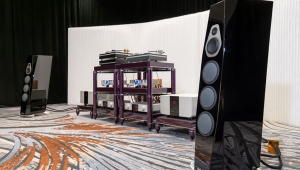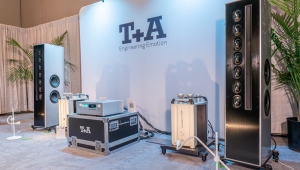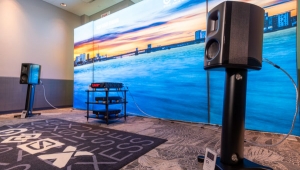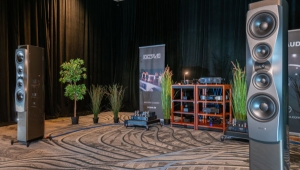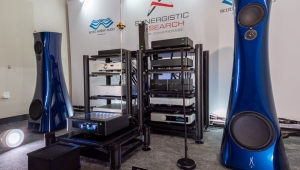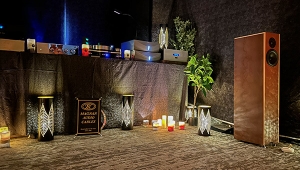| Columns Retired Columns & Blogs |
RSL Speedscreen II loudspeaker

RSL is the house brand of a California chain of retail stores, Rogersound Labs, that is part-owned by the leader of the RSL loudspeaker-design team, one Howard Rodgers. (Rogersound Labs also owns the Upscale Audio high-end store in north Los Angeles.) The range offered by RSL is unbelievably wide, with models addressing just about every market niche and price category. The Speedscreen II, however, is Howard's attempt to produce a true high-end loudspeaker at an affordable price. To the casual observer, the Speedscreen ($898/pair) appears to be a planar design; however, its shallow, braced enclosure houses moving-coil drive-units, and is a result of Howard's attempts to minimize the effect of cabinet resonances. "I always thought deep, narrow enclosures sound 'boxy'," said Howard when he visited Santa Fe last September, "and the wide but shallow cabinet seemed to be the best way to get a large internal volume without 'boxiness'."
The classic problem associated with wide baffles, however, is that in the upper midrange and treble, diffraction problems and reflections of the sound from the edges lead to often severe beaming, the so-called "Vertical-Venetian-Blind" effect. To minimize this in the Speedscreen II, Howard developed a soft moulded surround for the tweeter and midrange unit which is intended to absorb the treble energy emitted to the sides by the these drivers.
Looking at the drive-unit complement, the bottom of the baffle features a largish, flat passive radiator with a foam surround. This loads an 8" polypropylene-coned woofer mounted above it on a small sub-baffle. Unusually, this driver is rolled-off relatively early, above 600Hz, which means in musical terms it is only asked to reproduce fundamentals and low harmonics of most instruments and voices. The range from 600Hz to 9500Hz is handled by a 1.4" soft-dome unit sourced from Japan, while the top octave of treble is reproduced by a ribbon tweeter manufactured by Philips. (This actually uses an etched flat voice-coil on a plastic substrate and appears to be identical to the unit used as a supertweeter in the expensive Waveform design.)
The crossover features high-quality components—polypropylene capacitors and low-series-resistance, laminated-core inductors—and the internal wiring is all Monster Cable. Electrical connection is via gold-plated binding posts, and L-pad controls on the front panel offer a degree of cut or boost of the midrange and treble drivers. (In their minimum positions, these controls cut the level of their respective drivers completely.) A 3A fuse on the rear panel provides a degree of protection in case of extreme overload.
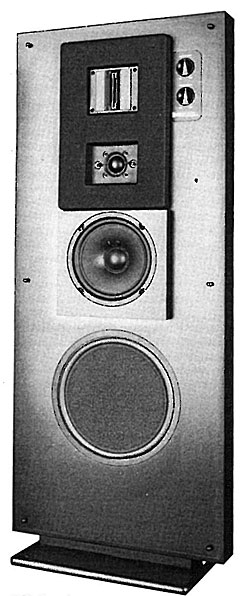 The sound
The sound
As Howard Rodgers was visiting when the speakers were delivered, I asked him to set the Speedscreens up in my listening room to sound as he would want. The speakers ended up firing straight ahead, some 4' from the side walls and 40" out from the rear wall. Though the speakers' bases are fitted with carpet-piercing spikes, these are not long enough to reach the floor beneath my carpet and ½" pad; I substituted Tiptoes. Howard had set the HF control to 1 o'clock and the midrange to 12 o'clock; ultimately, I preferred the treble balance with the HF control backed off somewhat, to the 12 o'clock position, and a little more upper-midrange energy to balance the lower midrange, the control being set at 2 o'clock. This was how I carried out all my auditioning and measurements.
My listening chair places my ears some 37" from the ground, which proved to be a little low for the Speedscreens: the most palpable treble balance was obtained with the listener's ears level with the ribbon tweeter. Listening to the tweeter on its own with a pink-noise signal revealed it to have a basically smooth nature, though, as with some other drivers of its type, the bottom edge of its passband sounded rather ragged. This driver also seems to have a very narrow dispersion pattern vertically, and sitting with my ears level with the midrange dome gave a rather hollow-sounding balance, as though there was a suckout in the upper crossover region. Laterally, it has much wider dispersion, but again care must be taken with positioning the speakers to get the optimum treble balance. With the speakers firing straight ahead as set up by Howard Rodgers, but with the HF control set to 12 noon as I preferred, the sound at the listening seat was evenly balanced. But if the speakers were moved farther apart, the sound lost body. In fact, despite the absorbent surround for the treble drivers, the wide baffle still seemed to endow the Speedscreen with horizontal dispersion problems, as the treble balance seemed critically dependent on speaker and listener position. From my experience with the speaker, the Speedscreen needs to be listened to from at least 9' away for the sound to properly integrate in the upper midrange and treble.
When optimally set up, however, and with the listener on the right axis, it was possible to get a very smooth-sounding balance—violins sounding excellent—with plenty of HF "air" around instruments.
I had also had problems getting an even balance at the other end of the frequency range. Though organ recordings revealed that the Speedscreens were capable of pumping out a satisfying level of low bass, and low-frequency definition was also good, the sound lacked a little upper-bass weight. Though the low bass could be felt through the floor, the entire bass region sounded shelved down compared with the lower midrange. Above the bass, the lower midrange had a rather forward, "gruff" quality that obscured the definition of tenor instruments such as the cello. This didn't affect the quality of spoken male voice, however, this being reproduced with an excellent lack of coloration other than a small degree of "quack." And piano reproduced with very little unevenness in the critical region in the octaves immediately above the treble staff, undoubtedly due to the fact that just one drive-unit handles the fundamentals and their harmonics for notes to the right of the piano's keyboard.
My only real criticism of the sound was in the integration between the lower midrange and the band above it, the region defined by the octave above middle C. Too often, I got the feeling of a "phasiness" in this region with the Speedscreen, of an aural confusion that didn't allow the music to gel. It is perhaps significant that this is the region where the woofer starts to cross over to the dome unit; the problem with using a separate midrange unit is that it is hard to find a frequency band to place the crossover that doesn't carry significant musical information.
The soundstage produced by the Speedscreens was big, there being a good sense of depth and the width extending to the outside edge of the speaker positions. Noticeable also was a sense of height when compared with the other two speakers I review this month. Stereo imaging, though reasonably well defined, was rather unstable, even small head movements causing the central image to swing quite wildly. I suspect that the wide baffle, again, is producing diffraction effects that interfere with the image stability as well as introducing beaming effects that change the tonal balance.
Dynamics seemed quite good, though it took a surprising amount of power to bring the sound to life, normally a sign that a speaker's balance is lacking in some areas.
All in all, however, this is pretty good performance for a pair of loudspeakers that costs significantly under $1000.
Conclusion
On the positive side, the Speedscreen II offers a "big" sound at a relatively affordable price, will not present drive problems to inexpensive amplifiers, and features a smooth, relatively uncolored treble and upper midrange. Debits include poor integration between the lower midrange and the rest of the mids, rather unstable imaging, fussiness in optimum setting up, and a bass region that, while extended, is shelved-down overall. It still represents good value for money, and readers in Southern California who find the Spica Angelus ($1275/pair), Vandersteen 2Ci ($1400/pair with stands), and Magnepan MG2.5R ($1695/pair) financially out of reach should check it out.
- Log in or register to post comments
